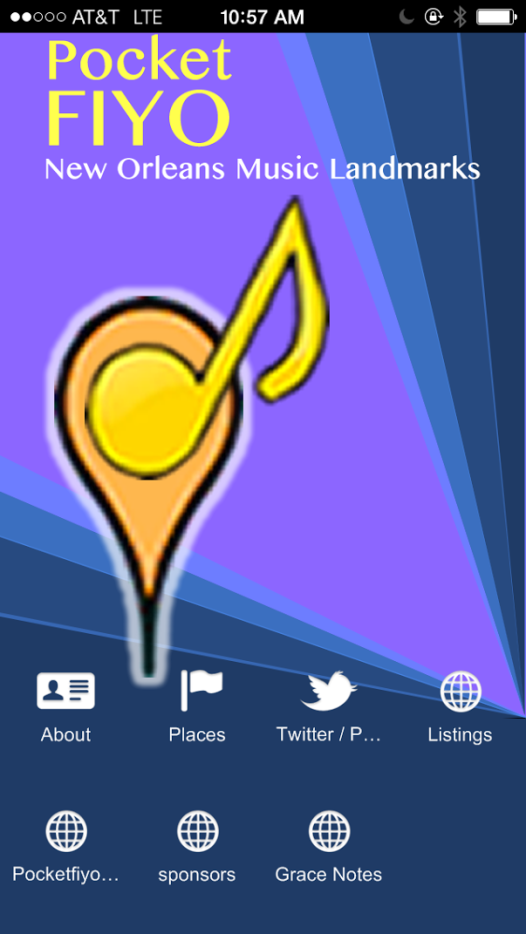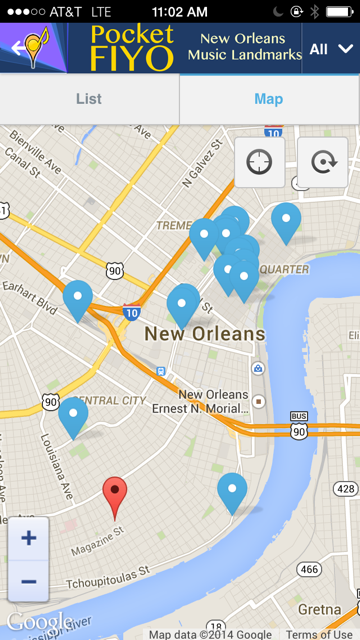New Orleanians know Dave Walker as the city’s premiere TV writer. What they may not know is that he also has a rock ‘n roll soul. A little-known fact: He once played drums with a band called the Zonies.
“We did mostly Stones covers and a 30-minute version of Louie Louie,” Walker says with characteristic understated humor. “We opened for the Beach Boys once, but we also played a lot of pool parties. Those were some of the happiest days of my life.”
So, years ago, when Walker was assigned to do a piece on Miami landmarks and ran across a few with musical underpinnings, like the hospital where Bob Marley died, it started a kind of cerebral itch.
“It sparked an interest in the connection between place and creativity,” explains Walker.
That led to a 1992 book, “American Rock ‘n Roll Tour,” which chronicled historic musical landmarks across the U.S. Joey Ramone, on the book’s back jacket, called it “the Rand McNally of rock and roll.” The book is long out of print, but the New Orleans public library has a copy; Walker checked when he moved to town 15 years ago.
New Orleans, where culture and sound are so intricately linked, continued to stoke the fires of Walker’s curiosity about music and enironment. So fast forward to 2014 and his new, digital version of mapping the connections between musical genius and place.
Pocket Fiyo is a smartphone app that uses the device’s location function to find nearby music landmarks and then tell you all about them.
is a smartphone app that uses the device’s location function to find nearby music landmarks and then tell you all about them.
The idea was born when, soon after getting an early-era smartphone, Walker ran across an app called Wiki Tap, still one of his favorites.
“It shows the closest Wikipedia entry to wherever you are,” Walker explains. So why not, he wondered, create something to show nearby musical landmarks?
“I messed around with it for years,” Walker says. “But I had no idea how to get it done. I met with an app developer, but that proved very expensive.”
Then, in March 2013, Walker was invited to pitch the project at a codemkrs.com music hackathon at UNO, where winning apps would be chosen for development.
“It was basically a three-minute explanation of what I wanted to do. I mentioned Wiki Tap, and everyone pulled their phones out.”
A group of students immediately signed up to carry out Walker’s vision. Could he be back the next morning with photos and content?
He could. “On the way back to UNO the next day, I stopped to take pictures of four music landmarks with my phone, which I emailed to them. By the time I got back to UNO, the app was built. They had stayed up all night creating it.”
It took another year to pull all the pieces together. Walker worked every weekend on Pocket Fiyo content, meticulously researching local places and people. The app covers all musical genres, from classical to hip-hop.
“It’s what I do, but this kind of research isn’t easy – all the facts are in books and people’s heads.”
He scoured local book collections, interviewed music mavens like classical music expert and Tulane professor John Baron, traveled the city documenting locales. With the help of son Mack, a UNO film major, he shot videos elucidating more musical lore, as with Ronnie Kole talking about the days when he played Al Hirt’s club.
Meanwhile, UNO student and hackathoner Julie Green continued engineering the mechanics. Together, they built out an accompanying website.
Pocket Fiyo launched during this year’s Jazz Fest, as both an iTune and Droid app. “It actually loaded on iTunes the morning of the first day, which was cool.”
The app started with 20 richly detailed locations that pinpoint some aspect of New Orleans music history. It’s a simple interface: Tap “places” on your phone screen to get nearby music landmarks, then any entry to get description, map and photo. “Read more” takes you to expanded content and reference links.
“I think of each entry as the least you need to know about it,” Walker says.
But Pocket Fiyo is not meant to be a guided city music tour. Rather, Walker sees it as a sort of serendipity.
“You’re sitting at Napoleon House and you have a couple of hours before your next convention session and you remember you have this app. So you click it and see that the Sonesta is a block away, where the Grateful Dead got busted for pot and then went on to write Truckin’.
“It’s more of an enlightenment device. Sort of like a gee-whiz-I-didn’t-know-that app. I see people pulling it out at a restaurant and saying, Hey, have you seen this?”
More than a year into his project, Walker still loves the happenstance of linking musician and place and discovering a creative result.
“Jerry Jeff Walker, as an itinerant street musician, serenaded a woman at Café du Monde and was taken to the old jail on Rampart Street, where he met a guy named Bojangles. That resulted in one of the most-recorded songs ever.”
Pocket Fiyo is set up as a non-profit, with proceeds going to two local music organizations, the New Orleans Musicians’ Clinic and The Roots of Music Marching Crusaders. Walker is taking nothing, and the app and website cost about $60 a month to run; anything above that will go to the music organizations. Walker hopes to fund the ongoing project with sponsors, who pay a small monthly fee to have their logos on the app as well as a sponsor locator map.
“In my mind’s eye I thought of all the small local clubs and restaurants that would want their brand in front of an engaged visitor or music lover.”
 Pocket Fiyo also includes music listings and, online, the interactive Grace Notes, where music lovers can post their own New Orleans music memories, as well as a curated blog of local music stories.
Pocket Fiyo also includes music listings and, online, the interactive Grace Notes, where music lovers can post their own New Orleans music memories, as well as a curated blog of local music stories.
“It’s meant to be a place where you can find all the relevant stories if there’s any news related to any of the landmarks, like when Cosimo Matassa died.”
The app’s launch locations are a mix of the obvious and the obscure: the French Opera House; Tad Gormley Stadium, where the Beatles played; the site of Louis Armstrong’s arrest for shooting a gun into the air (which sent him to the Colored Waifs’ home, where he learned to play a horn; “That shot, I do believe, started my career,” he would say later).
“I’ve shown it to New Orleanians and there’s always something they didn’t know – that Mahalia Jackson is buried on Airline Drive, or that Hank Williams got married in the Municipal Auditorium not long before he died. I myself knew nothing about the story of The Warehouse, and I really enjoyed researching that.”
Walker will continue to add locations and lore – in New Orleans and beyond.
“There’s a portal to music history around every corner in New Orleans,” he says. “I want to demonstrate the breadth of history in a snapshot. And New Orleans landmarks are worldwide. Kid Ory is buried in L.A. And Earl Palmer, too. The idea is that, when visitors go home, they can tap the app and discover something about where they live that they didn’t know about.”
Pocket Fiyo has attracted users from across the country. Walker finds, however, that the best way to explain his new app is simply to show it.
“Almost everybody who sees it says, what a cool idea,” Walker says. “To me, that’s the big payoff.”
 NOLAbeings Multimedia artist Claire Bangser created NOLAbeings as a portrait-based story project that marries...
NOLAbeings Multimedia artist Claire Bangser created NOLAbeings as a portrait-based story project that marries...  Voodoo in New Orleans: Reviving history: New Orleans fortune telling This article takes a deep dive into the history of Voodoo in New Orleans, its hybridization with Catholicism, and its present-day place in the city's culture. The author visits fortune-tellers in the French Quarter, using their guidance as a tool for introspection rather than a deterministic predictor of the future. Through her experiences in New Orleans, the author feels a mystical connection to both the past and the future.
Voodoo in New Orleans: Reviving history: New Orleans fortune telling This article takes a deep dive into the history of Voodoo in New Orleans, its hybridization with Catholicism, and its present-day place in the city's culture. The author visits fortune-tellers in the French Quarter, using their guidance as a tool for introspection rather than a deterministic predictor of the future. Through her experiences in New Orleans, the author feels a mystical connection to both the past and the future. 